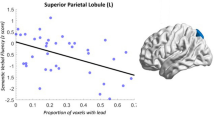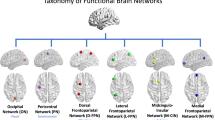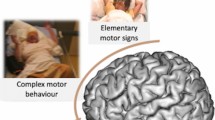Abstract
Growing evidence has demonstrated widespread brain network alterations in temporal lobe epilepsy (TLE). However, the relatively accurate portrait of the subcortical-cortical relationship for impaired consciousness in TLE remains unclear. We proposed that consciousness-impairing seizures may invade subcortical arousal system and corresponding cortical regions, resulting in functional abnormalities and information flow disturbances between subcortical and cortical networks. We performed resting-state fMRI in 26 patients with TLE and 30 matched healthy controls. All included patients were diagnosed with impaired awareness during focal temporal lobe seizures. Functional connectivity density was adopted to determine whether local or distant network alterations occurred in TLE, and Granger causality analysis (GCA) was utilized to assess the direction and magnitude of causal influence among these altered brain networks further. Patients showed increased local functional connectivity in several arousal structures, such as the midbrain, thalamus, and cortical regions including bilateral prefrontal cortex (PFC), left superior temporal pole, left posterior insula, and cerebellum (P < 0.05, FDR corrected). GCA analysis revealed that the casual effects among these regions in patients were significantly sparser than those in controls (P < 0.05, uncorrected), including decreased excitatory and inhibitory effects among the midbrain, thalamus and PFC, and decreased inhibitory effect from the cerebellum to PFC. These findings suggested that consciousness-impairing seizures in TLE are associated with functional alterations and disruption of information process between the subcortical arousal system and cortical network. Understanding the functional networks and innervation pathway involved in TLE can provide insights into the mechanism underlying seizure-related loss of consciousness.



Similar content being viewed by others
References
Berg, A. T. (2008). The natural history of mesial temporal lobe epilepsy. Current Opinion in Neurology, 21(2), 173–178. https://doi.org/10.1097/WCO.0b013e3282f36ccd.
Blumenfeld, H. (2012). Impaired consciousness in epilepsy. Lancet Neurology, 11(9), 814–826. https://doi.org/10.1016/S1474-4422(12)70188-6.
Blumenfeld, H., McNally, K. A., Vanderhill, S. D., Paige, A. L., Chung, R., Davis, K., Norden, A. D., Stokking, R., Studholme, C., Novotny Jr., E. J., Zubal, I. G., & Spencer, S. S. (2004). Positive and negative network correlations in temporal lobe epilepsy. Cerebral Cortex, 14(8), 892–902. https://doi.org/10.1093/cercor/bhh048.
Bostan, A. C., Dum, R. P., & Strick, P. L. (2010). The basal ganglia communicate with the cerebellum. Proceedings of the National Academy of Sciences of the United States of America, 107(18), 8452–8456.
Braakman, H. M., Vaessen, M. J., Hofman, P. A., Debeij-van Hall, M. H., Backes, W. H., Vles, J. S., et al. (2011). Cognitive and behavioral complications of frontal lobe epilepsy in children: A review of the literature. Epilepsia, 52(5), 849–856. https://doi.org/10.1111/j.1528-1167.2011.03057.x.
Danielson, N. B., Guo, J. N., & Blumenfeld, H. (2011). The default mode network and altered consciousness in epilepsy. [research support, N.I.H., extramural research support, non-U.S. Gov't review]. Behavioural Neurology, 24(1), 55–65. https://doi.org/10.3233/BEN-2011-0310.
de Lanerolle, N. C., Kim, J. H., Robbins, R. J., & Spencer, D. D. (1989). Hippocampal interneuron loss and plasticity in human temporal lobe epilepsy. Brain Research, 495(2), 387–395.
Edlow, B. L., Takahashi, E., Wu, O., Benner, T., Dai, G., Bu, L., Grant, P. E., Greer, D. M., Greenberg, S. M., Kinney, H. C., & Folkerth, R. D. (2012). Neuroanatomic connectivity of the human ascending arousal system critical to consciousness and its disorders. Journal of Neuropathology & Experimental Neurology, 71(6), 531–546.
Englot, D. J., & Blumenfeld, H. (2009). Consciousness and epilepsy: Why are complex-partial seizures complex? [research support, N.I.H., extramural research support, non-U.S. Gov't review]. Progress in Brain Research, 177, 147–170. https://doi.org/10.1016/S0079-6123(09)17711-7.
Englot, D. J., Mishra, A. M., Mansuripur, P. K., Herman, P., Hyder, F., & Blumenfeld, H. (2008). Remote effects of focal hippocampal seizures on the rat neocortex. [research support, N.I.H., extramural research support, non-U.S. Gov't]. The Journal of Neuroscience, 28(36), 9066–9081. https://doi.org/10.1523/JNEUROSCI.2014-08.2008.
Englot, D. J., Modi, B., Mishra, A. M., DeSalvo, M., Hyder, F., & Blumenfeld, H. (2009). Cortical deactivation induced by subcortical network dysfunction in limbic seizures. [research support, N.I.H., extramural research support, non-U.S. Gov't]. The Journal of Neuroscience, 29(41), 13006–13018. https://doi.org/10.1523/JNEUROSCI.3846-09.2009.
Englot, D. J., Konrad, P. E., & Morgan, V. L. (2016). Regional and global connectivity disturbances in focal epilepsy, related neurocognitive sequelae, and potential mechanistic underpinnings. Epilepsia, 57(10), 1546–1557.
Englot, D. J., D'Haese, P. F., Konrad, P. E., Jacobs, M. L., Gore, J. C., Abou-Khalil, B. W., et al. (2017). Functional connectivity disturbances of the ascending reticular activating system in temporal lobe epilepsy. Journal of Neurology, Neurosurgery, and Psychiatry, 88(11), 925–932. https://doi.org/10.1136/jnnp-2017-315732.
Escueta, A. V., Kunze, U., Waddell, G., Boxley, J., & Nadel, A. (1977). Lapse of consciousness and automatisms in temporal lobe epilepsy: A videotape analysis. Neurology, 27(2), 144–155.
Galanopoulou, A. S., & Moshe, S. L. (2009). The epileptic hypothesis: Developmentally related arguments based on animal models. Epilepsia, 50(Suppl 7), 37–42. https://doi.org/10.1111/j.1528-1167.2009.02217.x.
Goebel, R., Roebroeck, A., Kim, D. S., & Formisano, E. (2003). Investigating directed cortical interactions in time-resolved fMRI data using vector autoregressive modeling and granger causality mapping. [research support, non-U.S. Gov't]. Magnetic Resonance Imaging, 21(10), 1251–1261.
Granger, C. W. (1969). Investigating causal relations by econometric models and cross-spectral methods. Econometrica: Journal of the Econometric Society, 37, 424–438.
Grodd, W. (2001). Sensorimotor mapping of the human cerebellum: fMRI evidence of somatotopic organization. Human Brain Mapping, 13(2), 55–73.
Hamilton, J. P., Chen, G., Thomason, M. E., Schwartz, M. E., & Gotlib, I. H. (2011). Investigating neural primacy in major depressive disorder: Multivariate granger causality analysis of resting-state fMRI time-series data. Molecular Psychiatry, 16(7), 763–772.
He, X., Doucet, G. E., Sperling, M., Sharan, A., & Tracy, J. I. (2015). Reduced thalamocortical functional connectivity in temporal lobe epilepsy. Epilepsia, 56(10), 1571–1579. https://doi.org/10.1111/epi.13085.
Henderson, L. A., Rubin, T. K., & Macefield, V. G. (2011). Within-limb somatotopic representation of acute muscle pain in the human contralateral dorsal posterior insula. Human Brain Mapping, 32(10), 1592–1601.
Ji, G. J., Zhang, Z., Zhang, H., Wang, J., Liu, D. Q., Zang, Y. F., Liao, W., & Lu, G. (2013). Disrupted causal connectivity in mesial temporal lobe epilepsy. PLoS One, 8(5), e63183.
Kros, L., Eelkman Rooda, O. H., Spanke, J. K., Alva, P., Dongen, M. N., Karapatis, A., et al. (2015). Cerebellar output controls generalized spike-and-wave discharge occurrence. Annals of Neurology, 77(6), 1027–1049.
Laufs, H., Hamandi, K., Salek-Haddadi, A., Kleinschmidt, A. K., Duncan, J. S., & Lemieux, L. (2007). Temporal lobe interictal epileptic discharges affect cerebral activity in “default mode” brain regions. Human Brain Mapping, 28(10), 1023–1032.
Lee, K. H., Meador, K. J., Park, Y. D., King, D. W., Murro, A. M., Pillai, J. J., & Kaminski, R. J. (2002). Pathophysiology of altered consciousness during seizures: Subtraction SPECT study. [comparative study]. Neurology, 59(6), 841–846.
Liao, W., Zhang, Z., Pan, Z., Mantini, D., Ding, J., Duan, X., Luo, C., Lu, G., & Chen, H. (2010). Altered functional connectivity and small-world in mesial temporal lobe epilepsy. PLoS One, 5(1), e8525.
Moruzzi, G., & Magoun, H. W. (1995). Brain stem reticular formation and activation of the EEG. 1949. J Neuropsychiatry Clin Neurosci, 7(2), 251–267. https://doi.org/10.1176/jnp.7.2.251.
Motelow, J. E., Li, W., Zhan, Q., Mishra, A. M., Sachdev, R. N., Liu, G., et al. (2015). Decreased subcortical cholinergic arousal in focal seizures. [research support, N.I.H., extramural research support, non-U.S. Gov't]. Neuron, 85(3), 561–572. https://doi.org/10.1016/j.neuron.2014.12.058.
Palaniyappan, L., Simmonite, M., White, T. P., Liddle, E. B., & Liddle, P. F. (2013). Neural primacy of the salience processing system in schizophrenia. [research support, non-U.S. Gov't]. Neuron, 79(4), 814–828. https://doi.org/10.1016/j.neuron.2013.06.027.
Parks, E. L., & Madden, D. J. (2013). Brain connectivity and visual attention. Brain Connectivity, 3(4), 317–338. https://doi.org/10.1089/brain.2012.0139.
Parvizi, J., & Damasio, A. (2001). Consciousness and the brain. Neuroscience & Behavioral Physiology, 79(1), 135–160.
Pedersen, M., Curwood, E. K., Vaughan, D. N., Omidvarnia, A. H., & Jackson, G. D. (2016). Abnormal brain areas common to the focal epilepsies: Multivariate pattern analysis of fMRI. [research support, non-U.S. Gov't]. Brain Connectivity, 6(3), 208–215. https://doi.org/10.1089/brain.2015.0367.
Power, J. D., Barnes, K. A., Snyder, A. Z., Schlaggar, B. L., & Petersen, S. E. (2012). Spurious but systematic correlations in functional connectivity MRI networks arise from subject motion. Neuroimage, 59(3), 2142–2154. https://doi.org/10.1016/j.neuroimage.2011.10.018.
Proposal for revised classification of epilepsies and epileptic syndromes. Commission on Classification and Terminology of the International League Against Epilepsy. (1989). Epilepsia, 30(4), 389–399.
Proposal for revised clinical and electroencephalographic classification of epileptic seizures. From the Commission on Classification and Terminology of the International League Against Epilepsy. (1981). Epilepsia, 22(4), 489–501.
Shamshiri, E. A., Tierney, T. M., Centeno, M., St Pier, K., Pressler, R. M., Sharp, D. J., Perani, S., Cross, J. H., & Carmichael, D. W. (2017). Interictal activity is an important contributor to abnormal intrinsic network connectivity in paediatric focal epilepsy. Human Brain Mapping, 38(1), 221–236.
Sporns, O. (2009). From complex networks to intelligent systems: Springer Berlin Heidelberg, From Complex Networks to Intelligent Systems.
Squire, L. R. (2004). Memory systems of the brain: A brief history and current perspective. Neurobiology of Learning and Memory, 82(3), 171–177. https://doi.org/10.1016/j.nlm.2004.06.005.
Steriade, M. (1970). Ascending control of thalamic and cortical responsiveness. [review]. International Review of Neurobiology, 12, 87–144.
Theodore, W. H., Porter, R. J., & Penry, J. K. (1983). Complex partial seizures: clinical characteristics and differential diagnosis. Neurology, 33(9), 1115–1121.
Tomasi, D., & Volkow, N. D. (2010). Functional connectivity density mapping. Proceedings of the National Academy of Sciences of the United States of America, 107(21), 9885–9890. https://doi.org/10.1073/pnas.1001414107.
Ung, H., Cazares, C., Nanivadekar, A., Kini, L., Wagenaar, J., Becker, D., Krieger, A., Lucas, T., Litt, B., & Davis, K. A. (2017). Interictal epileptiform activity outside the seizure onset zone impacts cognition. Brain, 140(8), 2157–2168. https://doi.org/10.1093/brain/awx143.
Waites, A. B., Briellmann, R. S., Saling, M. M., Abbott, D. F., & Jackson, G. D. (2006). Functional connectivity networks are disrupted in left temporal lobe epilepsy. Annals of Neurology: Official Journal of the American Neurological Association and the Child Neurology. Society, 59(2), 335–343.
Wang, J., Wang, L., Zang, Y., Yang, H., Tang, H., Gong, Q., Chen, Z., Zhu, C., & He, Y. (2009). Parcellation-dependent small-world brain functional networks: A resting-state fMRI study. [research support, non-U.S. Gov't]. Human Brain Mapping, 30(5), 1511–1523. https://doi.org/10.1002/hbm.20623.
Zang, Z. X., Yan, C. G., Dong, Z. Y., Huang, J., & Zang, Y. F. (2012). Granger causality analysis implementation on MATLAB: A graphic user interface toolkit for fMRI data processing. Journal of Neuroscience Methods, 203(2), 418–426. https://doi.org/10.1016/j.jneumeth.2011.10.006.
Zeng, L. L., Shen, H., Liu, L., & Hu, D. (2014a). Unsupervised classification of major depression using functional connectivity MRI. Human Brain Mapping, 35(4), 1630–1641. https://doi.org/10.1002/hbm.22278.
Zeng, L. L., Wang, D., Fox, M. D., Sabuncu, M., Hu, D., Ge, M., Buckner, R. L., & Liu, H. (2014b). Neurobiological basis of head motion in brain imaging. Proceedings of the National Academy of Sciences of the United States of America, 111(16), 6058–6062. https://doi.org/10.1073/pnas.1317424111.
Zeng, L.-L., Wang, H., Hu, P., Yang, B., Pu, W., Shen, H., Chen, X., Liu, Z., Yin, H., Tan, Q., Wang, K., & Hu, D. (2018). Multi-site diagnostic classification of schizophrenia using discriminant deep learning with functional connectivity MRI. EBioMedicine, 30, 74–85.
Zhang, Z., Liao, W., Xu, Q., Wei, W., Zhou, H. J., Sun, K., Yang, F., Mantini, D., Ji, X., & Lu, G. (2017). Hippocampus-associated causal network of structural covariance measuring structural damage progression in temporal lobe epilepsy. Human Brain Mapping, 38(2), 753–766. https://doi.org/10.1002/hbm.23415.
Acknowledgements
We would like to express our gratitude to the patients and volunteers for participating in this study. This work was supported by the National Natural Science Foundation of China (81771407, 61533006, and 81471653).
Author information
Authors and Affiliations
Corresponding authors
Ethics declarations
Conflict of interest
Rong Li, Chongyu Hu, Liangcheng Wang, Ding Liu, Dingyang Liu, Wei Liao, Bo Xiao, Huafu Chen and Li Feng declare that they have no conflict of interest.
Informed consent
All procedures followed were in accordance with the ethnical standards of the responsible committee on human experimentation (institutional and national) and with the Helsinksi Declaration of 1975, and the applicable revisions at the time of the investigation. Informed consent was obtained from all patients for being included in the study.
Additional information
Publisher’s Note
Springer Nature remains neutral with regard to jurisdictional claims in published maps and institutional affiliations.
Electronic supplementary material
ESM 1
(DOCX 1274 kb)
Rights and permissions
About this article
Cite this article
Li, R., Hu, C., Wang, L. et al. Disruption of functional connectivity among subcortical arousal system and cortical networks in temporal lobe epilepsy. Brain Imaging and Behavior 14, 762–771 (2020). https://doi.org/10.1007/s11682-018-0014-y
Published:
Issue Date:
DOI: https://doi.org/10.1007/s11682-018-0014-y




